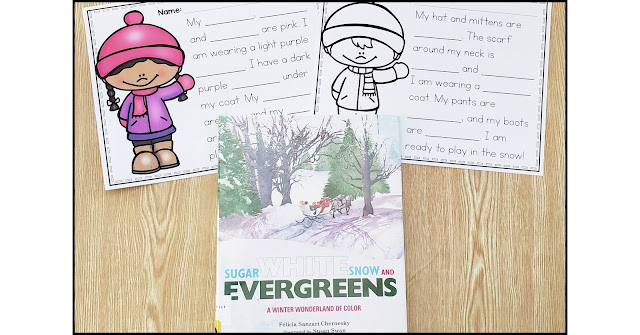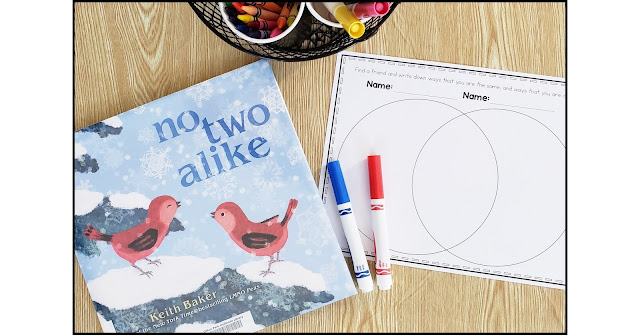When I decided to update my Vocabulary Units, I knew I wanted to include some interactive read-alouds. It is so important to read high quality, engaging texts to all students - English Language Learners are no exception. I was looking for books that would interest students, provide opportunities for discussions, and included rich vocabulary. I also wanted books that weren't too long so that primary level students would attend throughout the story. While I read and loved many winter themed books - these five were my final choices.
Snow by Manya Stojic
A quick and easy read, Snow by Manya Stojic is perfect for the primary classroom and English Language Learners in particular. The book begins with the wise owl making note of winter coming. Different animals confirm that they also can sense the Snow on the way. In the beginning of the book the illustrations include orange leaves flying around, hinting at the end of Autumn. In the middle of the book there is a brief look at how different animals survive winter, from bear who sleeps (Hibernation), the rabbits whose fur changes to white (Adaptation), and the geese who fly south (Migration). At the end of the book the owl and illustrations once again predict the season’s change, showing bits of green under the snow and mentioning spring.
Discussion Questions:
p. 5-6 Moose says, “I can smell it [snow] on the breeze.” What is a breeze? What else is blowing in the breeze? What season is ending?
p. 11-12 Fox says, “Those clouds are full of snow.” Where does snow come from? What else comes from the clouds? How are snow and rain related?
p. 19-20 The bunnies say, “We are as white as we can be, white as snow.” *looking back to pages 9-10* How did the bunnies change? Why did the bunnies fur turn white? This is called adaptation – changes to help an animal survive.
p. 21-22 Bear says, “Snow…snow…so…sleepy.” What does Bear do in winter? Why does Bear ‘sleep’ through the winter? This is called hibernation – when an animal becomes inactive, or sleeps, through the winter.
p. 25-26 The geese say, “South! We’ll fly south!” Why will the geese fly south? When will the geese come back? This is called migration – moving from one place to another
p. 27-28 What does Owl see that tells her spring is coming back? What happens to snow in the spring?
Post-Reading Activity:
After Reading Snow by Manya Stojic, create an anchor chart for the different ways animals survive the winter. Extend the activity by researching other animals that adapt, migrate, and hibernate.
Sugar White Snow and Evergreens: A Winter Wonderland of Color by Felicia Sanzari Chernesky, illustrated by Susan Swan
When you picture winter chances are good that you’re picturing a blanket of white. However this beautifully illustrated picture book points out all the other wonderful colors of winter. Sugar White Snow and Evergreens: A Winter Wonderland of Color by Felicia Sanzari Chernesky is a fun rhyming text that points out all the beautiful colors in the winter. The illustrations by Susan Swan are a lovely compliment to the text. From the obvious red cardinal and orange snowman’s nose to the more subtle purple shadows this book takes you through a verifiable rainbow of winter colors.
Discussion Questions:
Before Reading I want you to paint a picture of winter in your mind. What color did you use the most of? Why is white a very important color for the winter?
p. 3-4 The family is getting dressed to go outside. What do you wear to stay warm in the snow? What color is your coat, hat, mittens etc. ?
p. 5-6 They are going to ‘hunt’ for maple syrup. Have you ever had maple syrup? Do you know where it comes from? The text says they are going to a farm – What do you think they will see at the farm?
p. 17-18 The sap from the trees is boiled, or heated, until all the water evaporates and all that is left is the syrup. Why are their stomachs growling? Have you ever been so hungry your stomach growled?
p. 23-24 Notice the trees on the previous page are bare… What happened to their leaves? How are those trees different from these trees on this page? Evergreen trees do not lose their needles in the winter.
p. 27-28 What do you see on these pages and what colors are they?
Post-Reading Activity
Ask students to write about their winter weather gear (coat, boots, etc.). As they write they should include color words to describe the winter clothes. For beginner level students provide sentence stems, such as "My coat is _____." or "I wear a _____ coat.".
Winter is the Warmest Season by Lauren Stringer
Another text that contradicts the way we usually think about winter, Winter is the Warmest Season, by Lauren Stringer, is a fun book about how warm winter actually is. The author compares summer things like fans that blow cold air to the radiators that bring heat in the winter-time. The author also talks about how animals and people like to get closer together to stay warm. The illustrations are bold and colorful. They go along perfectly with the text and will lend to students’ understanding of the text.
Discussion Questions:
Before Reading I want you to think about winter. What does winter feel like? Most people think of winter as being COLD! However, this book talks about all the ways that winter is warm.
p. 2-3 The boy is getting dressed to go outside. What do you wear to stay warm in the snow? The book says, “My hands wear warm wooly sweaters.” What is on the boy’s hands?
p. 4-5 What animals do you see sleeping under a thick blanket of snow? These animals are hibernating - when an animal becomes inactive, or sleeps, through the winter.
p.8-9 Radiators are a type of heater in older homes. They often make hissing and clanking sounds when they are on. How do you keep your house warm?
p. 16-17 The boy is comparing summer swims with winter baths. Why does going for a cold swim feel good in the summer? Why does a warm bath feel good in the winter? Which one do you like better? Why?
After Reading Which do you think the boy likes better? Summer or Winter? Why?
Post Reading Activity:
Brainstorm ways to stay warm in the winter. You can do this as a class, or individually. If it's more appropriate for your students, allow them to draw a picture of how they stay warm in the winter.
Best in Snow by April Pulley Sayre
I love Best in Snow by April Pulley Sayre for its us of real photographs. The close-up photos of snow and ice are especially fascinating. Each photograph has just a few words to accompany it, making the photographs the driving force in this book. At the end of the text the author includes some notes about the scientific processes snow goes through as it changes over time. A great way to show students that snow comes in all different forms – fluffy and fun, to icy and hard.
Discussion Questions:
p. 2-3 Where does snow come from? What else comes from the clouds? How are snow and rain related?
p. 12-13 These three pictures show different snowstorms. How is the snow in these pictures different from one another.
p. 14-15 What do you think causes the sparkle in the snow?
p. 20-21 What happens to snow as the air gets warmer? Where do you usually see icicles?
p. 24-25 When the melting snow mixes with mud it makes slush. Where do you usually see slushy snow?
After Reading What animals did you see in this book? How do you think they feel about the snow?
Post-Reading Activity:
Ask each student to choose their favorite photograph from the book. Then they can describe everything they see in the image. This is great for descriptive writing and noticing details.
No Two Alike by Keith Baker
No Two Alike by Keith Baker is a fast and fun rhyming text that points out differences you can see in winter. The book starts out with the fact that no two snowflakes are alike. The illustrations even have easily discernable flakes, so that you can see the differences. The two cardinals show off other winter differences such as animal homes, and different winter trees. In the end even their differences are pointed out. The text is a great reminder of how each one of us is unique – just like snowflakes.
Discussion Questions:
p. 2-3 Did you know that each snowflake is different? Look closely at the snowflakes in the birds’ flight path – notice how they are different.
p. 6-7 On this page we see two nests. Who are these nests homes for? How are the nests the same? And how are the different?
p. 12-13 This picture of the forest shows two different types of trees. Why are some trees bare? The evergreen trees do not lose their needles in the winter.
p. 16-17 How are these two roads different? Where do you think they might lead?
p. 24-25 What animals do you see in the forest? What are they doing?
p. 30-31 Even the two cardinals are just a little bit different, but they are still good friends. Are you friends with someone who is different from you?
Post- Reading Activity:
After Reading, pair students to create a Venn Diagram of the ways in which they are the same and the ways they are different. This is such a great lesson on how we can be friends with someone who isn't exactly like us!
If you are looking for these discussion questions and activities ready-to-print and use please check them out in either my Winter Vocabulary Unit or my Winter Read-Alouds resource in my Teachers Pay Teachers store. If you chose to read any of these books with your students I'd love to hear about it! You can e-mail me at TeachingEternity@gmail.com, or connect with me on Instagram, @TeachingEternity.
Click the Image for a Winter Picture Book List













